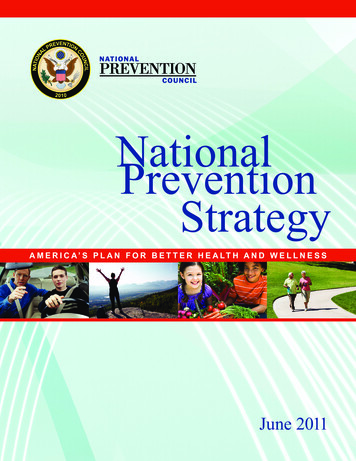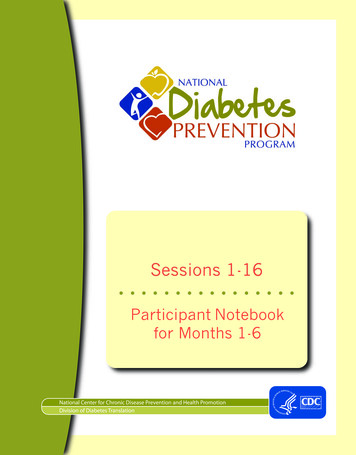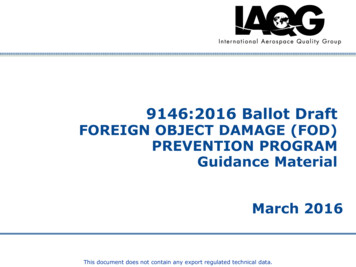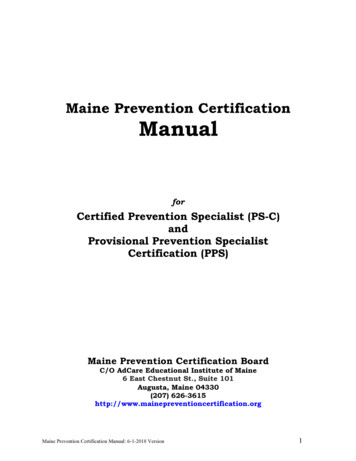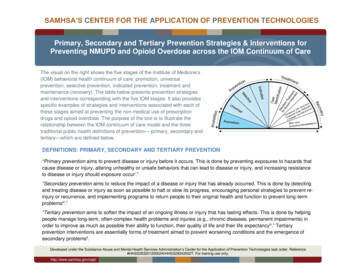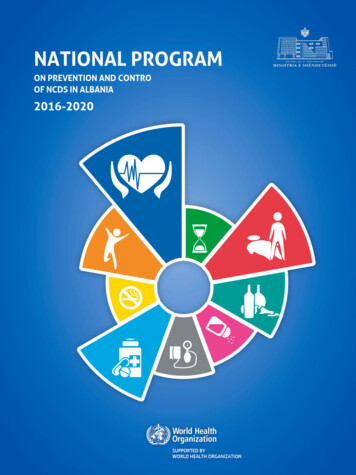
Transcription
National Program on Preventionand Control of NCDs in Albania2016-2020Tirana, 2017SUPPORTED BYWORLD HEALTH ORGANIZATION
2
ForewordThe cross-sector NCD program is built onMinistry of Education and Sports: Linda Pustinathe above policy strategies and programs byMinistry of Transport and Infrastructure: Argitacombining and integrating the efforts of a numberTotozaniof stakeholders from both governmental andnon-governmental organizations to achieve theNCD targets aligned with the WHO NCD Globalmonitoring framework.Program has been developed with the inputof line ministries: Ministry of Health, MinistryMinistry of Agriculture, Rural Development andWater Administration: Edi FerroMinistry of Environment: Jonila HaxhillariUniversity of Medicine: Enver Roshi, GencBurazeriof Agriculture, Rural Development and WaterUniversity Hospital Centre “Mother Teresa”:Administration, Ministry of Education and Sports,Mihal Tase, Artan Goda, Agron Ylli, Geront Husi,Ministry of Environment, Ministry of Transport andLeonard SimoniInfrastructure, the respective local and nationalUniversity Hospital “Shefqet Ndroqi”: Perlatinstitutions and nongovernment organization.KapisyziContributors in the compilation of the NationalAlbanian Association of Palliative Care: KristoProgram on Prevention and Control of NCDs inHutaAlbania 2016-2020General Physicians Academy : Artenca CollakuMinistry of Health: Klodian Rjepaj, GazmendCentre “ Grupimi Ecolevizja “: Xhemal MatoBejtja, Jonida SeferiThe intersectorial group was supported by theInstitute of Public Health: Arjan Bregu, Alban Ylli,WHO providing technical assistance through allSonela Xinxo, Ervin Toçithe process of compilation of the program.National Program on Prevention and Control of NCDs in Albania 2016-20203
Foreword by the Minister of HealthNon-communicable diseases (NCDs) are a majorconcern in Albania, exhibiting a significant increaseduring the period 1990-2010, a trend which is likelyto continue in the future given the increase in lifeexpectancy and aging of the Albanian population.The main NCDs include cardiovascular diseases,chronic respiratory conditions, diabetes andcancer. All of these conditions often share commonmodifiable risk factors, including lifestyle/behavioral risk factors (such as tobacco use,unhealthy dietary patterns and physical inactivity)and some other classical/conventional risk factors(including blood pressure, high glucose and highcholesterol levels).WHO estimates that NCDs account for about of90% of the deaths in Albania and the probabilityof dying between ages 30 and 70 years from the4 main NCDs is about 19%. The cardiovasculardisease is the top cause of mortality in Albaniaaccounting for 59% of all deaths.According to the Global Burden of Disease 2010Study, the three main risk factors responsible forthe majority of the burden of disease in 2010 inAlbania included dietary risk factors, hypertensionand smoking. The overall lifestyle factors accountedfor more than 70% the total burden of diseasein Albania, whereas dietary risk factors alonecomprised 38% of the total mortality in Albania.A comprehensive approach is being employedby integrating policy and action to reduceinequalities in health and tackling the toll of NCDsby introducing health promotion and preventiveprograms at a population level; actively targetingsub-groups and individuals at a particularly highrisk; and, maximizing population coverage witheffective health care services.The priority activities are organized withinfour strategic objectives including governance,prevention, health system and surveillance.With a commitment and vision to provide UniversalHealth Coverage and quality and timely healthservices for all Albanian residents, the AlbanianPrograme for the prevention and control of NCDsaims at avoiding premature death and significantlyreducing the disease burden from NCD by takingintegrated action, improving the quality of life and4making healthy life expectancy more equitablewithin and between the Regions.As we have embarked on a challenging pathto radically reform the country’s healthcaresystem, we shall continue strengthening andexpanding of the role of the Primary Health Care,as the gatekeeper of the system, through theimplementation of the National Programme ofFree-of-charge Check-up for all Albanian Residentsaged 35-70, removal of all fees for medical visits atthe PHC level for all citizens, despite their healthinsurance status, and further expanding the list ofreimbursed medicines.Furthermore, our efforts aim at strengthening of thecontinuum of care for the management of NCDs,specifically: Tobacco control; CVDs: Upgradingthe currently dispersed outpatient CardiologyCabinets and the establishment of new inpatientinvasive cardiology units (angioplasty) in the capitaland other major district and use of all availableresources for specialized treatment of CVD-sthrough PPP schemes; Cancer control: Screening ofcolorectal cancer through the annual free checkup programme, screening and early detection ofbreast cancer through the use of stationary and twomobile mammography machines, establishmentof chemotherapy treatment units in major districthospitals, upgrade of radiotherapy, improved accessto medicines used for the treatment of cancer(expansion of the list of reimbursed medicines),establishment of palliative care centers in districts;and finally, our endeavors to further develop theHealth Information System and integrate its silos:e-Prescription; e-Referral; development of a modelof the electronic medical chart at the hospital level,establishment of the system of electronic medicalfiles at the PHC level.Overall, the proposed inter-sectoral NCD programin Albania will build on the existing policystrategies and programs combining and integratingthe efforts of a number of stakeholders bothgovernmental and non-government organization toachieve the NCD targets aligned to the WHO NCDGlobal monitoring framework.Minister of HealthIlir Beqaj
Foreword by the Deputy Ministerof HealthNon-communicable diseases are currently theleading cause of death, diseases and disability inthe Europe region, putting an increasing strain onhealth systems, economic development and thewell-being of most of the population.health systems; Health in all policies; A life courseapproach; Empowerment; Balancing interventionstargeted for the whole population and thevulnerable groups; Integrated programs; ‘Wholeof-society’ approach.According to the last situation analysis, noncommunicable diseases are a major concern inAlbania, depicting a clear increase during 19902010, a trend likely to continue in the future aswell, in the context of increased life expectancyand population aging.The process of drafting the program has gonethrough several steps of discussions with allstakeholders involved in the National Committeefor the Prevention and Control of Chronic Diseasesand with a continuing technical support fromthe World Health Organization Country Office inAlbania.The program aims to prevent and control NCDsand thus avoid premature death and significantlyreduce the burden of diseases from NCD by takingintegrated action, improving the quality of life andmaking healthy life expectancy more equitablewithin and between Regions.The drafting of the program was based on: The 4 year program 2013-2017 of theAlbanian government. Its primary goal is theextension of healthy life years for Albaniancitizens and preventing premature deathsthrough maintaining and improving health National Program for the EuropeanIntegration Upcoming Health Strategy 2016-2020The guiding principles of the program and of theimplementation plan in particular are: Health asa human right; Focus on equity; StrengtheningThe proposed program outlines short termpriorities for action to be addressed over thecoming two years (2017-2018). Considerations forthe selection of these actions include alignmentto the EU integration agenda, feasibility, costeffectiveness and political support.The priority activities are organized within 4strategic objectives: governance, prevention,health system and surveillance.The implementation of the program will enable notonly the achievement of the vision and objectivesof the Albanian Government and the Ministry ofHealth, but it will also enhance the technical skillof the health professionals in accomplishing theirduties and responsibilities.Dr. Klodian RjepajDeputy Minister of HealthNational Program on Prevention and Control of NCDs in Albania 2016-20205
List of DSCUHCUNDAFUNFPAUNICEFUSAIDYRBSWHO6Albanian Demographic and Health Survey 2008-09Body Mass IndexChildhood Obesity Surveillance InitiativeCardiovascular DiseaseDisability Adjusted Life yearsDemographic and Health SurveyEuropean School Survey Project on Alcohol and Other DrugEuropean UnionHealth Care Mandatory Insurance FundHealth Behaviour in School-aged ChildrenInstitute of StatisticsIschemic Heart DiseaseInstitute of Public HealthInstitute of Education DevelopmentInternational Atomic Energy AgencyInstitute of Food Safety and Veterinary ResearchGlobal Youth Tobacco SurveyFramework Convention Tobacco ControlLocal GovernmentMillennium Development GoalsMinistry of Education and SportsMinistry of FinanceMinistry of HealthMinistry of InteriorMinistry of JusticeMinistry of Social Welfare and YouthNational Cancer Control Action PlanNational Centre on Continuous EducationNo communicable DiseasesNational Centre of Emergency CareNational Centre of Quality Safety and Accreditation of Health InstitutionsNational Health ReportNational Health InspectorateNational Food AuthorityNon-Governmental OrganizationsNicotine Replacement TherapyPublic Health Regional DirectorySwiss CooperationUniversity Hospital CentreUnited Nations Development Assistance FrameworkUnited Nations Population FundUnited Nations Children’s FundUnited States Agency for International DevelopmentYouth Risk Behaviour SurveyWorld Health Organization
Table of contentsForeword 3Foreword by the Minister of Health 4Foreword by the Deputy Minister of Health 5List of Abbreviations 6Table of contents 7Introduction 8Regional context of Non communicable diseases 8Existing NCD related policies and programs in Albania 9Situation analysis 9Mortality 9Morbidity 10Risk factors 11Strategic Framework 12Vision 12Goal 12Objectives 12Strategic approach 12Guiding principles 12Priority action areas 13Overall Targets 14Action plan 15Non- Communicable Disease Prevention and Control Implementation Plan 2016–2020 in Albania 15Reference 30National Program on Prevention and Control of NCDs in Albania 2016-20207
IntroductionRegional context of Noncommunicable diseasesbecause of disability and shortage of skilledNon communicable diseases (NCDs) are theIn this regard, the UN Political Declaration on Nonleading cause of death, disease and disabilitycommunicable Diseases (NCDs) in 2011 cast thein the WHO European Region. In Europe, NCDsspotlight on NCDs as a growing and substantive(more broadly defined) account for nearly 86% ofthreat to sustainable human and economicdeaths and 77% of the disease burden, puttingdevelopment [4].NCDs are increasingly becomingan increasing strain on health systems, economicthe cause of premature death and disabilitiesdevelopment and the well-being of most ofworldwide, and are draining healthcare budgetsthe population, people over 50 years of age inin both developed and developing economies Inparticular [1]. The four major NCDs (cardiovascular2015, the new Sustainable Development Goalsdisease, cancer, chronic obstructive pulmonary(SDGs) [5], unlike the Millennium Developmentdiseases and diabetes) account for the vastGoals [6], include a target for reduced prematuremajority of the disease burden and of themortality caused by NCDs as well as targetspremature mortality in the Region.related to key risk factors for NCDs.NCDs have a significant macroeconomic impactThe WHO Global Action Plan for the Preventionand exacerbate poverty. Most NCDs are chronicand Control of NCDs, 2013-2020 highlights theand require repeated interactions with thecost-effective interventions for the preventionhealth system and recurring and continuousand control of NCDs in four key areas: (i) tobaccomedical expenses, often requiring catastrophic,control; (ii) harmful use of alcohol; (iii) unhealthyimpoverishing expenditure. It has been estimateddiet; and (iv) physical inactivity. They savethat the loss of productivity due to NCDs isindividuals’, communities’ and governments’significant: for every 10% increase in NCDmoney in both the short and long term. Theymortality, the economic growth decreases byare all evidence-based, high-impact, cost-0.5%[2].effective, affordable and feasible. Although theseNCDs are also barriers to sustainable developmentof the human capital. People in many countriesexperience NCDs at younger ages; have longerperiods of illnesses; increased prematuredeaths; and increased obesity. The rise of NCDsamong younger populations is jeopardizing the“demographic dividend” – the economic benefitsexpected when a relatively large part of thepopulation is of working age. Business leaderssurveyed by the World Economic Forum [3], in8workers.interventions are simple to execute, some requirepolitical commitment and coordinated crossgovernment action. Acting alone, ministries ofhealth are confined to remedial action and illnesstreatment while a whole-of-government approachis required to address the NCDs social causes.In addition, strategic engagement with the civilsociety, the academia, the professional bodies andselected private entities are also important whenit comes to tackling NCDs [7].particular those in countries where healthcareIn July 2014, Member States undertook aquality and access are perceived as poor, reportcomprehensive review and assessment on thea high degree of concern that their companies’prevention and control of NCDs and the progressperformance will be damaged because ofsince the UN Political Declaration on NCDs inNCDs among employees. NCDs contribute to2011 [8]. Key national commitments agreed at thatabsenteeism, poor performance on the jobmeeting included:
1. setting national targets for NCDs for 2025;the NCD targets aligned with the WHO NCD Global2. developing national multisectoral NCDmonitoring framework.policies and plans to achieve the targets;3. considering the establishment of nationalmultisectoral mechanism for engagingpolicy coherence and mutual accountabilityin different NCD-related spheres of policymaking;4. reducing NCD risk factors by implementinginterventions identified in the WHO NCDGlobal Action Plan, 2013-2020 [7].Existing NCD related policies andprograms in AlbaniaNCD control and prevention has been consideredas one of priorities of the government. In thisregard, NCD control and prevention was includedin the legislation on the health sector suchas the Law 10107 of 30.03.2009 “On HealthCare in Albania”, Law 10 383, of 24.2.2011 “OnCompulsory Insurance of Health Care in Republicof Albania”, Law 10 138, of 11.5.2009 “On PublicHealth”, Law 44/2012 “On Mental Health”, Law9636, of 6.11.2006 “On Health Protection fromTobacco Products”, Law 9518, of 18.4.2006 “OnProtection of Minors from Use of Alcohol” or inexisting action plans such as the Cancer ControlStrategy and Action Plan 2011-2020, the MentalHealth Action Plan 2013-2021, the Food andNutrition Policy Discussion Paper 2013-2020.NCD- related issues have also been included inextended Government policy documents: Albanian government’s 4 year program2013-2017 - The primary goal is theextension of healthy life years of Albanian Situation analysisAccording to 2014 National Health Report, noncommunicable diseases are a major concern inAlbania, depicting a clear increase during 19902010, a trend likely to continue in the future aswell, in the context of increased life expectancyand aging of the population.The prioritized NCDs consist of cardiovasculardisease, chronic respiratory conditions (asthma/COPD [chronic obstructive pulmonary disease]),diabetes, breast and cervical cancer, anddepression. The first three diseases share commonmodifiable risk factors, including behavioral riskfactors (such as tobacco use and unhealthy diet)and physiologic risk factors (such as high bloodpressure and high cholesterol level).MortalityThe mortality profile of Albania is similar to thatof developed countries. According the WHO data,NCDs account for about of 90% deaths in Albaniaand the probability of dying between their 30sand 70s of the 4 main NCDs is about 19%. Thecardiovascular diseases are the top cause ofmortality in Albania accounting for 59% of alldeaths (Figure 1).The National Health Report 2014 [9] reported anincreased mortality rate from non-communicablediseases (SIZ, Neoplasm, Diabetes and COPD)during the last two decades (Table 1).Table 1.The crude mortality and standardized deathrates from the NCD during the last two decades inAlbaniacitizens and prevention of prematureSJI1990deaths by maintaining and improvingSIZ81172125155healthCerebrovascular disease92163144147National Program for European IntegrationNeoplasm74136104124Upcoming Health Strategy 2016-2020Diabetes374613192017The proposed cross-sector NCD program shallCOPD2010 1990* 2010*build on the above policy strategies and programs* Standardized death rate per 100,000.by combining and integrating the efforts of aSource. National Health Report, 2014 Albania.number of stakeholders from both governmentaland non-governmental organizations to achieveNational Program on Prevention and Control of NCDs in Albania 2016-20209
Figure 1: Specific mortality ( % of death for all ages and both sexes*)DiabetChronic respiratory disease5%1%other NCD16%9%Communicable, perinatal, maternaland nutricional conditionsCancer5%5%InjuriesCVD59%MorbidityThe share of NCDs as a percentage of total DALYsIn 1990-2010, the share of total NCDs and selectedincreased considerably from 2000 to 2012 inNCDs as a percentage of total DALYs has increasedAlbania (Figure 2).as well (Figure 3).Figure 2. NCDs as percentage of total DALYs in Albania in2000 and 2012Figure 3.Total NCDs and selected NCDs as percentage oftotal DALYs in Albania in 1990 and 2012Source. National Health Report, 2014 Albania.10NCDin totalCVDCancer4.0RespiratoryChronicDiseaseSource. National Health Report, 2014 Albania.4.45.2OtherNCD
Risk factorsAccording to the national health report, which isBurden Disease, 2010).based on the data of global burden of diseasesIn 2010, lifestyle factors accounted for more thanof 2010, the three risk factors responsible for the70% the total burden of diseases in Albania andmajority of the burden of diseases in 2010 werediet accounted for 38% of the total mortality indiet, arterial hypertension and smoking (the GlobalAlbania.Table 3. Burden of diseases attributable to the overall lifestyle/behavioral factors in Albania in 1990 and 2010Year: 1990Lifestyle factorDALYs (per 100,000)Physical inactivityYear 2010Percent DALYsDALYs (per 100,000)Percent High body-mass index1116.73.92241.88.2High blood pressure2600.89.14199.715.3High total cholesterol651.42.31073.93.9High fasting plasma glucose770.62.71281.94.7Drug use268.80.9369.21.3Dietary risksLow bone mineral densityAlcohol use433.21.5956.23.5Smoking2856.39.93313.512.1Total lifestyle11650.940.619501.771.2Source: National Health Report, 2014, Albania.According to the Survey of Substance Use AmongIn 2010, dietary risks accounted for about 44% ofThe General Population In Albania [10] the smokingthe NCD mortality and 22% of the burden of NCDsprevalence among men was 43.3 % and amongin general (Table 4). Dietary risk factors includewomen was 10.7% (Figure 4).individual behavior ranging from excess calorieFigure 4.Current smoking prevalence by gender amonggeneral population aged 15-65, Albania, 2014intake to salt intake, unsaturated fats, processedmeat, lack of fruits and vegetables intake, or transfats.Table 4.Mortality rate and burden of NCDs attributableto dietary risks in Albania in selected years43.310.7MaleFemaleSource: Survey of Substance Use among the GeneralPopulation in Albania 2014.Indicator1990Dietary risksattributable CMRfrom NCDs (per100,000)144.2 216.3 284.2 254.2 271.0Dietary risksattributable CMRfrom NCDs (%)Dietary risksattributableDALYs for NCDs(per 100,000)Dietary risksattributableDALYs for NCDs(%)40.6199552.8200054.8200543.8201043.72907.3 4129.6 5224.1 4683.9 4813.817.322.926.322.622.4Source: National Health Report, 2014, Albania.National Program on Prevention and Control of NCDs in Albania 2016-202011
Recent surveys [11] indicate a high prevalenceof overweight/obesity and hypertension in thegeneral population of Albania (Figure 5).Figure 5.Prevalence of hypertension among generalpopulation aged 15-49 years, Albania, 2009 (ADHS2009)Figure 5.Prevalence of overweight and obesity amonggeneral population aged 15-49 years, Albania, 2009(ADHS .3118958.5Male9.7Female15-19 20-24 25-29 30-34 35-40 41-44 44-49According to the HBSC 2014, only 1 in 4 childrenengages in at least 1 hour of moderated orintensive daily physical activity [12].Strategic FrameworkVisionStrategic approachPromoting health free of preventable noA comprehensive approach that systematicallycommunicable disease (NCD), premature death andintegrates policy and action to reduce inequalitiespreventable disability in Albaniain health and tackles NCDs by simultaneously:1. Promoting health promotion and diseaseGoalThe goal of the Albanian Program for theprevention and control of NCDs is to avoidprevention programs at population-level;2. Actively targeting groups and individuals athigh risk; and,premature death and significantly reduce thedisease burden from NCD by taking integrated3. Maximizing population coverage witheffective treatment and care.action, improving the quality of life and makinghealthy life expectancy more equitable within andbetween Regions.Objectives To take integrated action on risk factors andtheir underlying determinants across sectors To strengthen health systems for improvedprevention and control of NCD.12Guiding principlesThe guiding principles for this implemented planare as follows: Health as a human right A focus on equity Strengthening health systems
Health in all policiesPrevention: Scaling up equity-sensitive A life course approachpopulation interventions to address risk factors Empowerment Balance population-based and individualapproaches Integrated programs ‘Whole-of-society’ approachPriority action areasThe proposed program outlines short termand their underlying social determinants1. Whole-of-government policies2. Work with the municipalities to create theconditions for health (pedestrian friendlycity centers and bike lanes, green areas).Enhanced role of the local government forhealth.3. Promote sports and physical activity,priorities for action to be addressed over thestarting from schools. Revise and updatecoming two years (2017-2018). Considerations forthe school curricula on physical educationthe selection of these actions include alignmentand nutrition.to the EU integration agenda, feasibility, cost-4. Promote and sustain the ‘open school’effectiveness [13] and political support. Otherinitiative to facilitate physical activity at theareas for action have been identified over thecommunity level.period 2016-2020 and are expressed in theappended NCD Action Plan, but they will requireadditional consultations with relevant partners.The priority activities are organized within 4strategic objectives: governance, prevention,health system and surveillance.Governance: strengthening and expanding crosssector cooperation and partnership for NCD1. Strengthen the role of the cross-sectorcommittee on NCDs by assigning it thespecific responsibility of overseeingthe development, implementation5. Create healthy choice environment byproviding the fruit schemes and enforceregulations on street vendors.6. Enforce current tobacco policies byexpanding the capacity of the State HealthInspectorate;7. Upgrade the current tobacco regulationthrough effective health warnings (pictorialwarnings on the packaging) and reduceaffordability of tobacco products byincreasing tobacco excise taxes.8. Collaborate with the social sector toand evaluation of the plan to ensureidentify and address social determinantsengagement, policy coherence, jointof health related especially to excludedaccountability and clear reporting lines.strata of the population in order to facilitate2. To ensure its feasibility the plan needs to beincorporated within the mid-term programsof the government budget review.3. Mobilize commitment from a full range ofpartners in and outside the health sector(NGO, private sector, academia). Takeadvantage of initiatives at local level forcreating healthy environments and scalingup awareness campaigns.4. Expand the capacity of the Ministry ofHealth in the area of NCDs.5. Include NGO-s in the next iteration ofUNDAF.better access to health services.9. Prepare and identify key stakeholders toreduce salt content in bread.Population-based actions1. Raise awareness on the healthy eatinghabits and nutrition and outdoor activitiesthrough the social media, campaigns andprofessional education.2. Promote breastfeeding;3. Health system: Strengthen integrationand rational use of services for improvedmanagement of NCDNational Program on Prevention and Control of NCDs in Albania 2016-202013
Early detection and management Build on the existing check-up initiative system (Freeperiodic national comprehensive risk factorNational Program of Health Check-up for Albaniansurveys based on WHO STEPS.Citizens 35-70 years of age covering NCDs early available databases;1. Strengthen the counseling skills of GPs onthe risk factors;2. Identify and further follow up thepopulation at risk for NCDs, especially forCVD through SCORE included in the checkup program;3. Establish outpatient fully equippedOverall Targets(based on targets and indicators in line with theWHO Global Monitoring Framework )1. Halt the rise of premature mortality from NCD Unconditional probability of dyingbetween the ages of 30 and 70 from CVDs,cabinets of CVD countrywide to ensurecancer, diabetes or chronic respiratorythe proper follow up of patients who havedisease.indications for further medical work-out;4. Enable access to services of advancedStrengthen the analytical capacities both atnational and local levels to analyze differentdetection and screening):2. Alcohollife saving interventions in cardiology, Halt the rise among womenemergency care and oncology. Reduce consumption among men5. Use all available public and private Halt the rise of binge drinking amongresources in the country.6. Strengthen health communication andeducation component of the programadolescents3. Tobacco 7. Prepare the ground for the development ofthe cervical screening program in line withthe National Cancer Control Action Plan.8. Expand palliative care services.Lifting the financial barriers and administrativebarriers1. Ensure that the uninsured populationreceives services free of charge at theprimary health care level.2. Increased access to medicines: loweredmedicine prices (for both outpatient andinpatient) through regulatory means.Surveillance-Research (HIA): Establish acomprehensive and coordinated national NCDsurveillance system Reduce prevalence of tobacco use amongadolescents Halt the rise among women Reduce prevalence among the adultpopulation4. Physical activity Reduce physical inactivity among schoolaged children by 10%5. Hypertension Relative reduction of the prevalence of HBPby 10%6. Diabetes and obesity Halt the rise of obesity7. Health system response Advance the implementation of target andindicators across institutions in line withAt least 50% of eligible at-risk populationundergoes the appropriate therapy Improve access to essential medicinesECHI, GMF, SDGs;required to treat major NCDsScale up the child nutrition surveillance 0-5(by 25%)years old countrywide;Other targets and indicators will be deve
National Program on Prevention and Control of NCDs in Albania 2016-2020 3 The cross-sector NCD program is built on the above policy strategies and programs by combining and integrating the efforts of a number of stakeholders from both governmental and non-governmental organizations to achieve the NCD targets aligned with the WHO NCD Global
